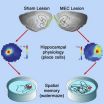(Press-News.org) VIDEO:
Dartmouth researchers say lung cancer screening in the National Lung Screening Trial meets a commonly accepted standard for cost effectiveness as reported in the Nov. 6 issue of the New...
Click here for more information.
Dartmouth researchers say lung cancer screening in the National Lung Screening Trial (NLST) meets a commonly accepted standard for cost effectiveness as reported in the Nov. 6 issue of the New England Journal of Medicine. This relatively new screening test uses annual low-dose CT scans to spot lung tumors early in individuals facing the highest risks of lung cancer due to age and smoking history.
"The takeaway from this study is that there is potential for lung cancer screening to be done in a cost-effective manner, particularly for adults 65-75 years of age," said William C. Black, MD, chair of the Lung Cancer Screening Group at Dartmouth-Hitchcock Medical Center and professor of Radiology, of Community & Family Medicine, and of The Dartmouth Institute for Health Policy and Clinical Practice, Geisel School of Medicine at Dartmouth. Black is principal author of the paper (read the full paper here)and a leading national researcher of lung cancer screening.
The Dartmouth study found that screening costs $81,000 for each quality-adjusted year of life it produces. The statistic, known as Cost per Quality-Adjusted-Life-Years (QALYs), considers the overall costs of a medical intervention to a selected population to produce one year of perfect health. For policy makers, this ratio establishes relative worth from an economic perspective. A proposed benchmark for cost-effectiveness is $100,000-$150,000 QALY.
"I think the vast majority of health economists would consider the threshold to be close to $100,000 per QALY," said Black.
When the researchers looked at specific subgroups of study participants, they found lung cancer screening was most cost-effective for current smokers, women, and for people in their sixties.
"Although precision with subsets is not as good as overall, people at higher risk seemed to benefit more from screening, so, for example, current smokers benefited much more than people who had quit," said Black.
Lung cancer screening is not yet standard medical practice. Over the last two years, multiple professional associations have issued statements that recommend physicians offer annual lung cancer screening to individuals 55-80 years old who have more than a 30-pack years history of smoking.
As a result of a positive recommendation (Grade B) handed down by the U.S. Preventive Services Task Force in December, 2013, commercial insurers will be required to cover the test as a preventive service with no co-pays or deductibles. The Centers for Medicare and Medicaid Services (CMS), however, has yet to issue its final decision on reimbursement. A preliminary panel recommended against coverage by CMS this past spring. The final report from CMS is expected in the next week.
In this study Dartmouth researchers evaluated more than 53,000 participants in the seven-year NLST. This randomized control study was the one credited for proving that low-dose CT screening for lung cancer can save lives. For each 1,000 people screened there were about three fewer deaths from lung cancer. NLST followed strict protocols and the results of this study do not necessarily apply to lung cancer screening programs implemented differently.
Lung cancer screening is not without risks. In the NLST, roughly one-third of those screened had a "false alarm" requiring further testing, usually a repeat of the CT scan, to rule out lung cancer. Some additional tests are invasive and come with a small risk of serious complications.
Since the NLST was conducted, the American College of Radiology (ACR) narrowed its definitions of a "positive" lung cancer screening test. This stricter guideline should substantively decrease the number of false alarms resulting from the test.
"The new ACR LungRADs reporting system should reduce the false positive rate by about 50 percent," said Black, "and reduce the cost-effectiveness ratio by several thousand dollars per QALY gained."
INFORMATION:
The study was conducted in collaboration with investigators at the Brown School of Public Health, Pardee RAND Graduate School, University of California at Los Angeles, University of Minnesota School of Public Health, and the University of South Carolina at Charlestown. Co-authors included Ilana F. Gareen, Samir S. Soneji, JoRean D. Sicks, Emmett B. Keeler, Denise R. Aberle, Arash Naeim, Timothy R. Church, Gerard A. Silvestri, Jeremy Gorelick, and Constantine Gatsonis.
The study was funded by the National Cancer Institute; National Lung Screening Trial ClinicalTrials.gov number, NCT00047385.
About Norris Cotton Cancer Center at Dartmouth-Hitchcock
Norris Cotton Cancer Center combines advanced cancer research at Dartmouth and the Geisel School of Medicine with patient-centered cancer care provided at Dartmouth-Hitchcock Medical Center, at Dartmouth-Hitchcock regional locations in Manchester, Nashua, and Keene, NH, and St. Johnsbury, VT, and at 12 partner hospitals throughout New Hampshire and Vermont. It is one of 41 centers nationwide to earn the National Cancer Institute's "Comprehensive Cancer Center" designation. Learn more about Norris Cotton Cancer Center research, programs, and clinical trials online at cancer.dartmouth.edu.
Imagine being able to recognize your car as your own but never being able to remember where you parked it. Researchers at University of California, San Diego School of Medicine have induced this all-too-common human experience - or a close version of it - permanently in rats and from what is observed perhaps derive clues about why strokes and Alzheimer's disease can destroy a person's sense of direction.
The findings are published online in the current issue of Cell Reports.
Grid cells and other specialized nerve cells in the brain, known as "place cells," comprise ...
Cats and humans have shared the same households for at least 9,000 years, but we still know very little about how our feline friends became domesticated. An analysis of the cat genome by researchers at Washington University School of Medicine in St. Louis reveals some surprising clues.
The research appears Nov. 10 in the Proceedings of the National Academy of Sciences Early Edition.
Cats have a relatively recent history of domestication compared with dogs; canines arose from wolves over 30,000 years ago.
"Cats, unlike dogs, are really only semidomesticated," said ...
A massive new University of Colorado Boulder study indicates there is a statistical link between hotter temperatures generated by climate change and the risk of armed conflicts in sub-Saharan Africa.
CU-Boulder Professor John O'Loughlin led a research team that assessed more than 78,000 armed conflicts between 1980 and 2012 in the Sahel region of Africa - a semi-arid belt just south of the Saharan Desert that spans about 3,000 miles and more than a dozen countries from the Atlantic to the Indian oceans.
The team was looking for links between armed conflicts and temperature ...
HOUSTON - (Nov. 10, 2014) - An analysis of more than 100 health insurance plans across Texas offered under the Affordable Care Act (ACA) shows that plans can differ significantly in premium cost and the number of hospitals included in insurance networks. That's just one of the findings of a report released today by the Episcopal Health Foundation and Rice University's Baker Institute for Public Policy.
The report examined "Silver" health insurance plans offered by insurers within the ACA's Marketplace. Texas is divided into 26 different geographic areas, with different ...
Philadelphia, PA, November 10, 2014 - Beta-blockers have been a cornerstone in the treatment of heart attack survivors for more than a quarter of a century. However, many of the data predate contemporary medical therapy such as reperfusion, statins, and antiplatelet agents, and recent data have called the role of beta-blockers into question. Two new studies published in The American Journal of Medicine evaluated the traditional management of these patients after their discharge from the hospital and in the light of changing medical treatment, as well as the impact of the ...
The adult human body is made up of about 37 trillion cells. Microbes, mainly bacteria, outnumber body cells by 10 to 1. Increasingly, scientists recognize that this huge community of microbes, called the microbiome, affects the health, development and evolution of all multicellular organisms, including humans.
Studies show symbiotic microbes can help prevent infection by disease-causing pathogens. But sometimes the interaction goes the other way, with a pathogen or disease disrupting the normal community of symbiotic bacteria. In a new study, a team of scientists from ...
ANN ARBOR--In a step toward robots smaller than a grain of sand, University of Michigan researchers have shown how chains of self-assembling particles could serve as electrically activated muscles in the tiny machines.
So-called microbots would be handy in many areas, particularly medicine and manufacturing. But several challenges lie between current technologies and science fiction possibilities. Two of the big ones are building the 'bots and making them mobile.
"We are inspired by ideas of microscopic robots," said Michael Solomon, a professor of chemical engineering. ...
BUFFALO, N.Y. - Most people rarely sing publicly outside of a duty-bound rendition of "Happy Birthday." And since that particular song is usually offered as a group performance, even the reluctant join in the spirit of the occasion, hoping their individual shortcomings will be cloaked by the chorus.
"I can't sing," says the hesitant performer. But a University at Buffalo psychologist believes that most people are not as bad at singing as they might think and he is collaborating on the development of an online test that will evaluate participants' ability to match specific ...
Boulder, Colo. -- Nov. 10, 2014 -- When the double asteroid Patroclus-Menoetius passed directly in front of a star on the night of Oct. 20, a team of volunteer astronomers across the U.S. was waiting.
Observing the event, known as an occultation, from multiple sites where each observer recorded the precise time the star was obscured, yielded the first accurate determination of the two objects' size and shape. The analysis was led by Dr. Marc W. Buie, staff scientist in Southwest Research Institute's (SwRI) Space Studies Department in Boulder, Colo.
The team effort was ...
Scientists at the University of Arizona have discovered what might be the closest thing to "baby photos" of our solar system. A young star called HD 95086 is found to have two dust belts, analogous to the asteroid and Kuiper belts in the Solar System, surrounded by a large dust halo that only young planetary systems have.
Similar dust structures are also found around another, slightly older star called HR 8799, where four massive planets occupy the large gap between the two belts. HR 8799, the first star found to host four directly imaged planets, is often referred ...




